State of Minnesota vs. Max Mason. Case No. 22590. 1921-1922. Opinion and Syllabus.
Images
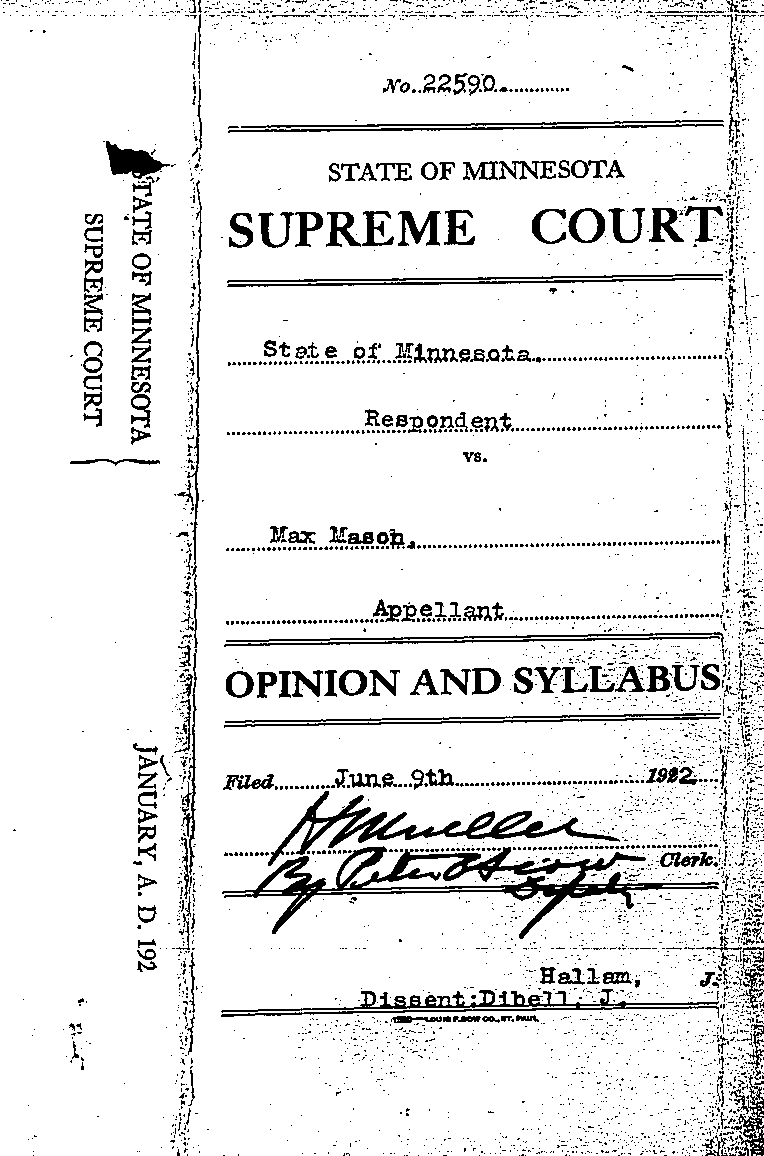
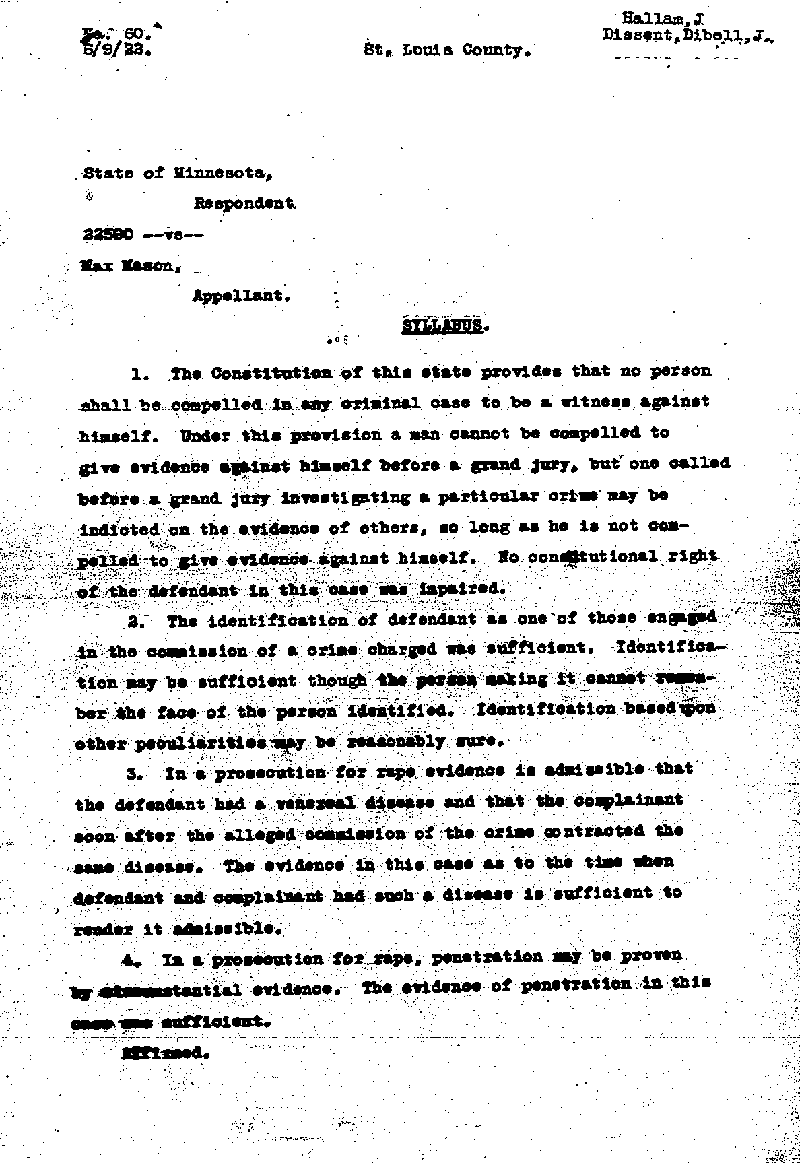
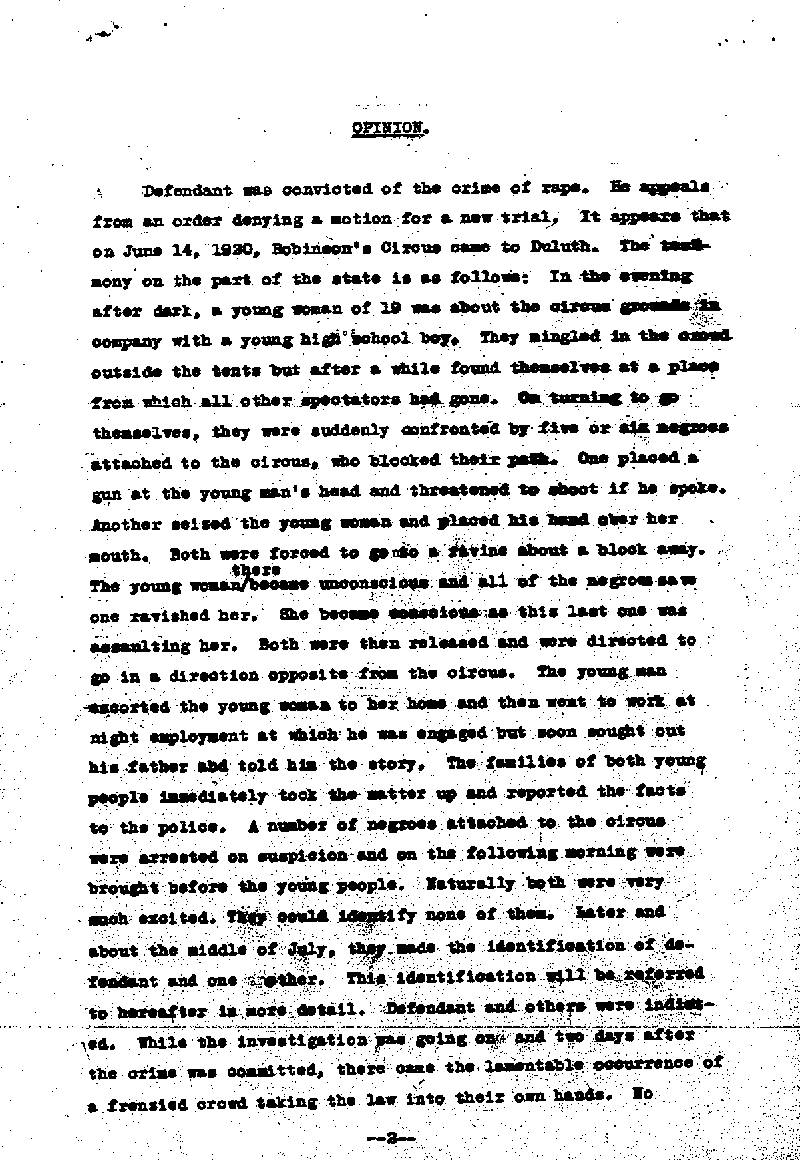
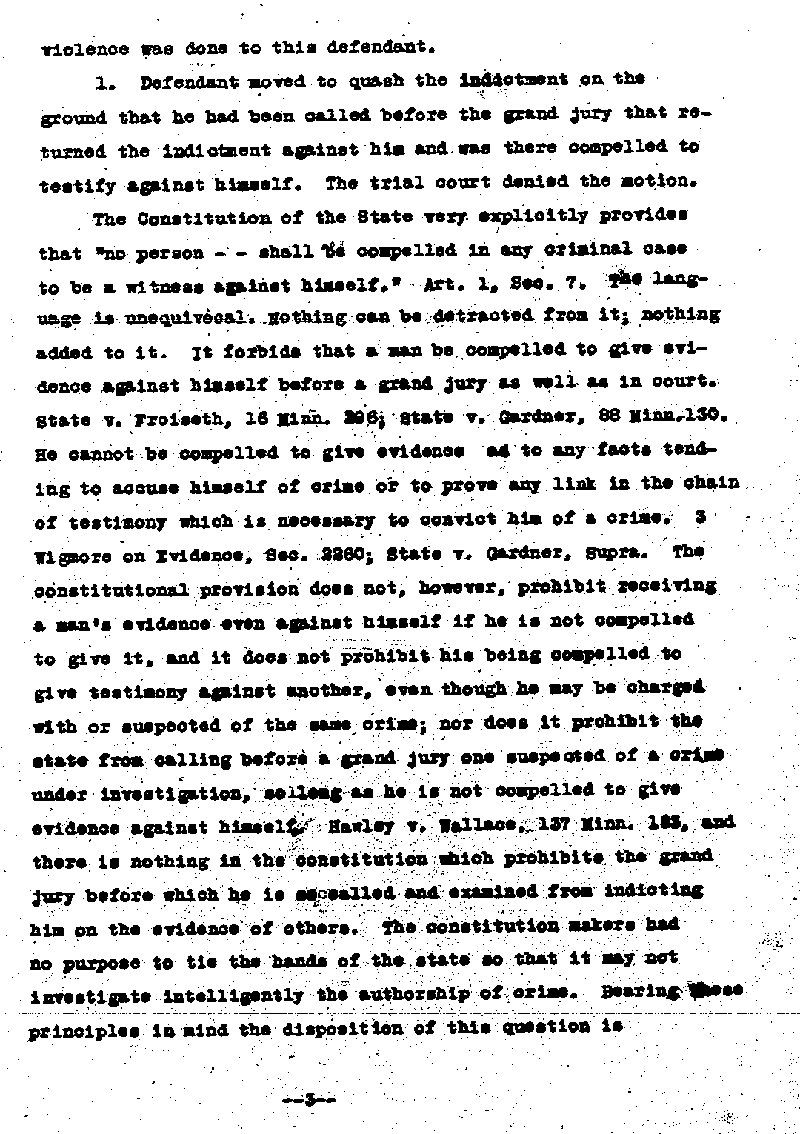
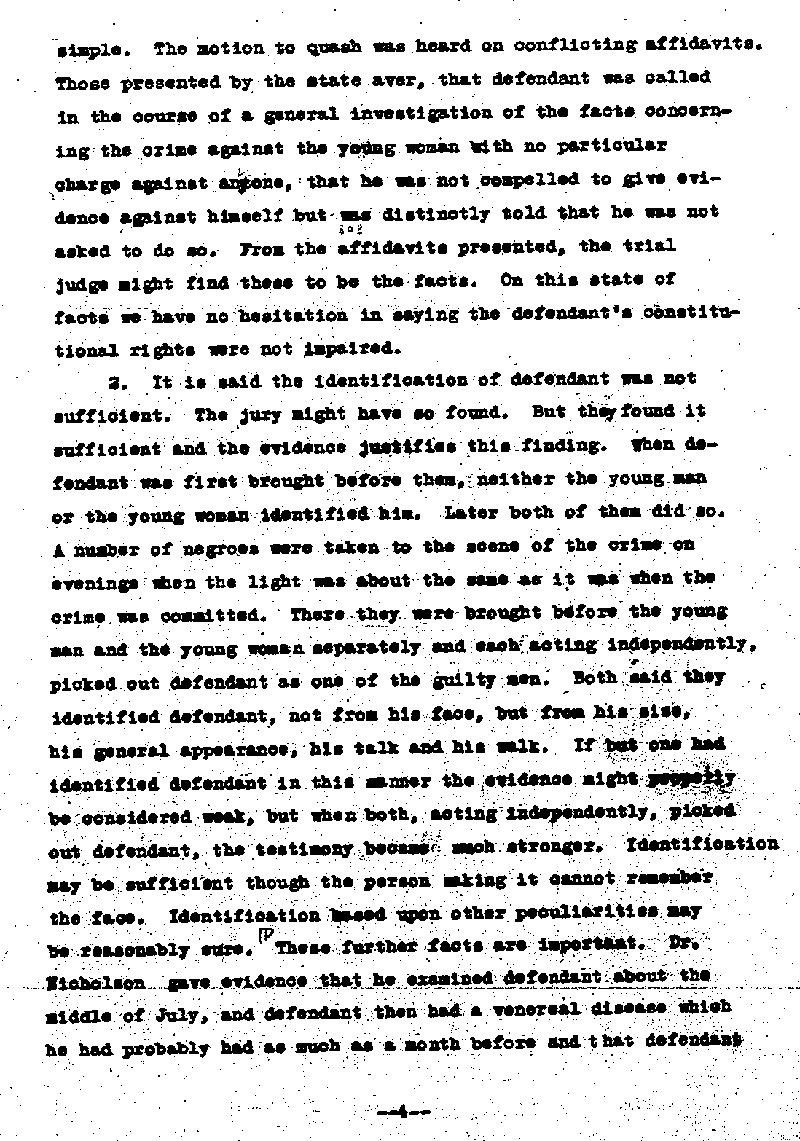
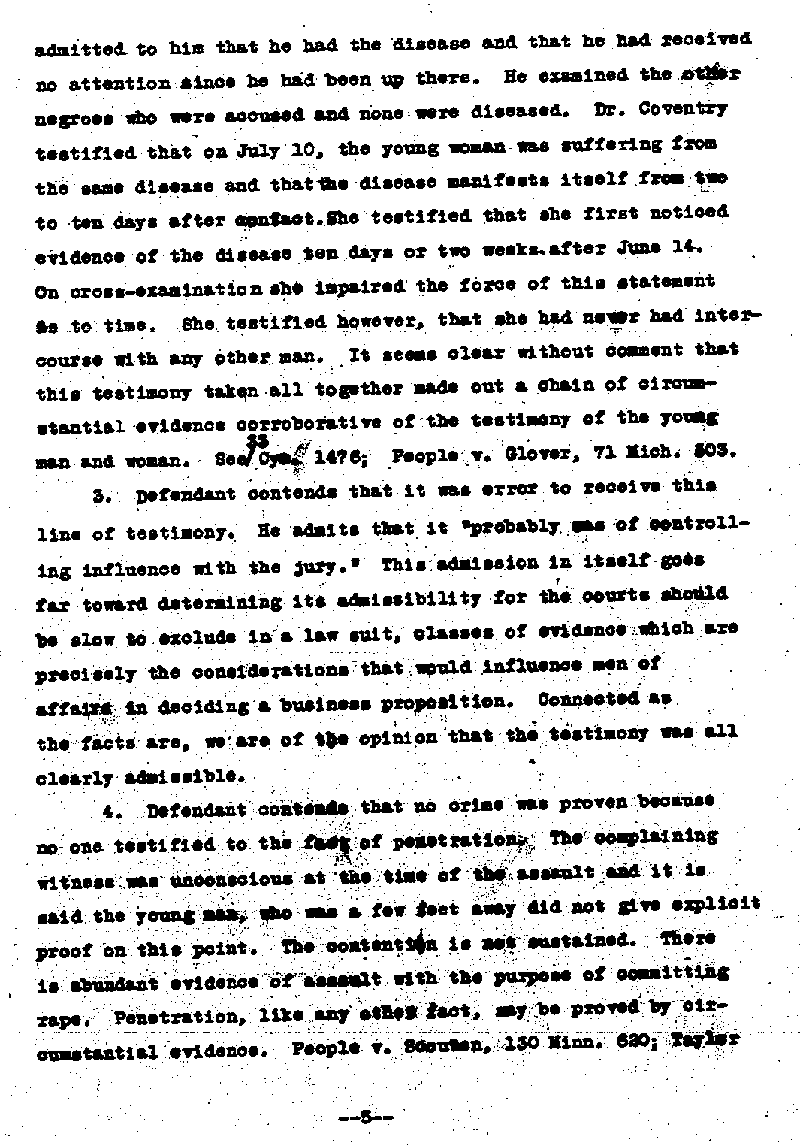
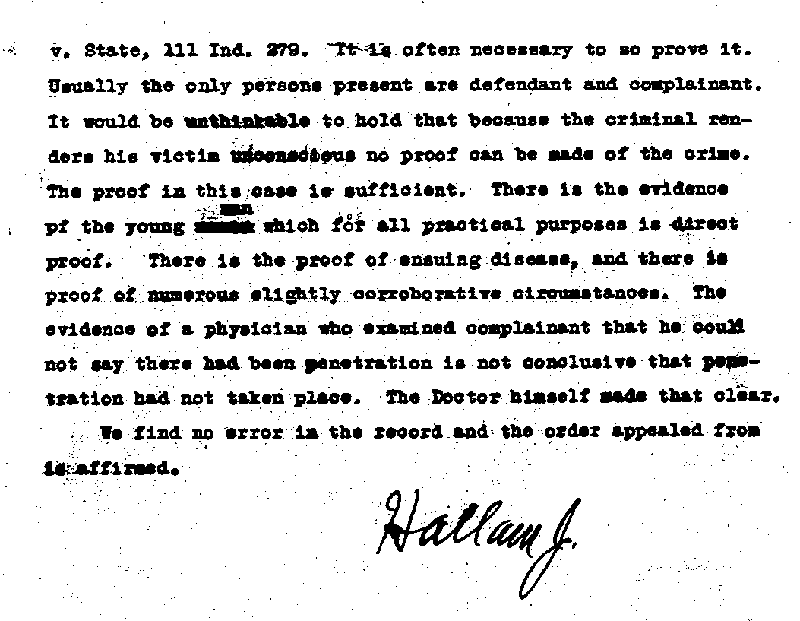
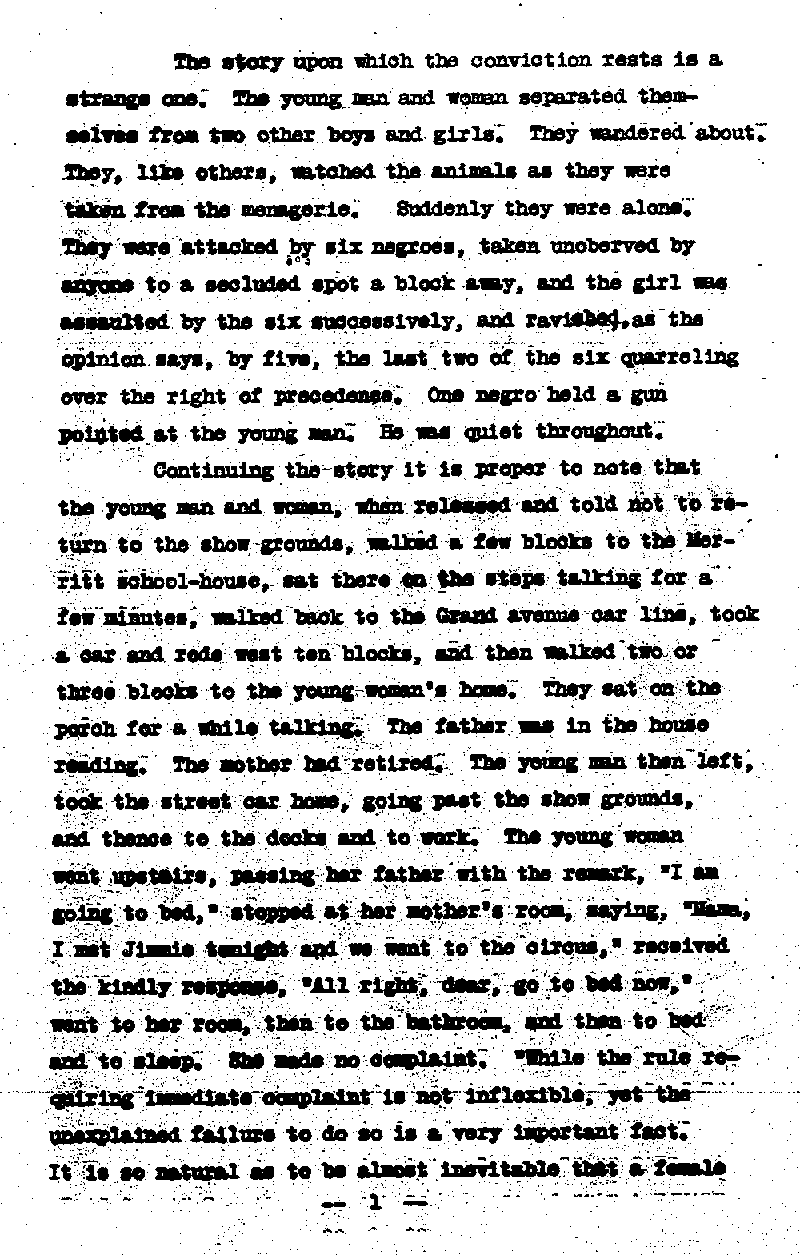
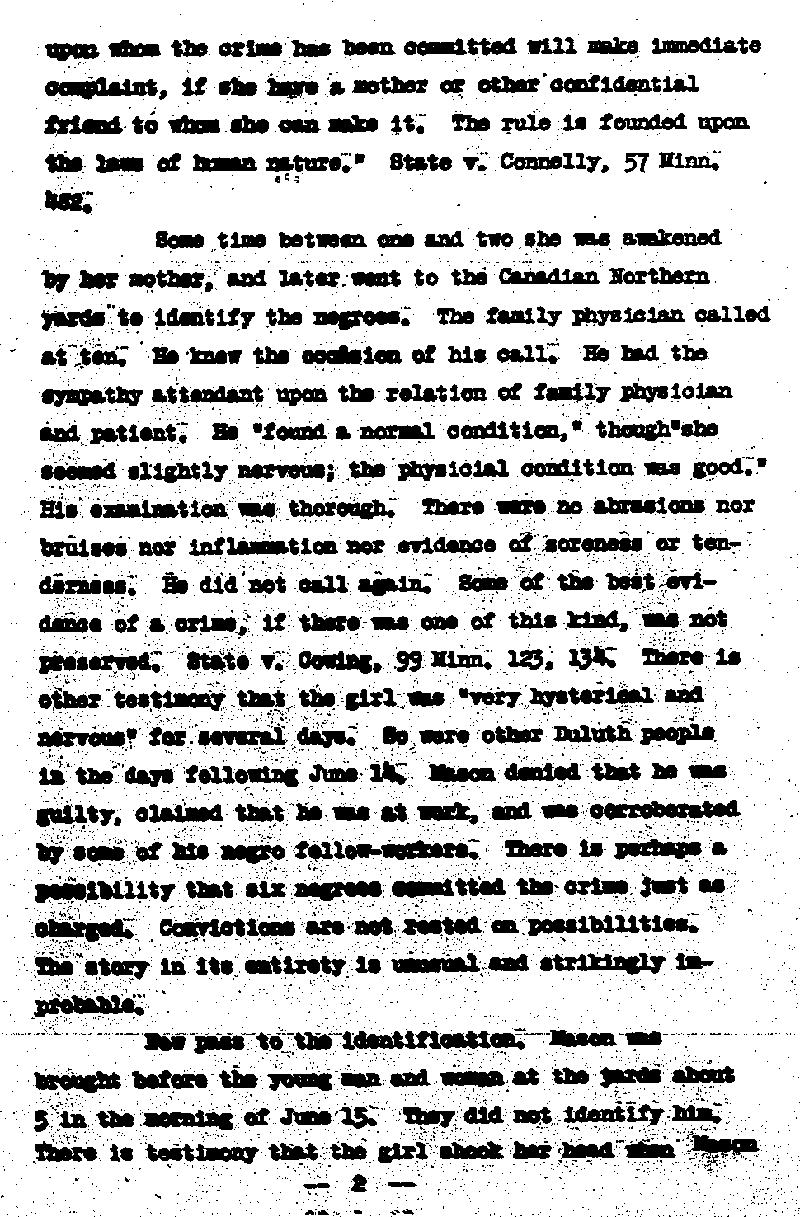
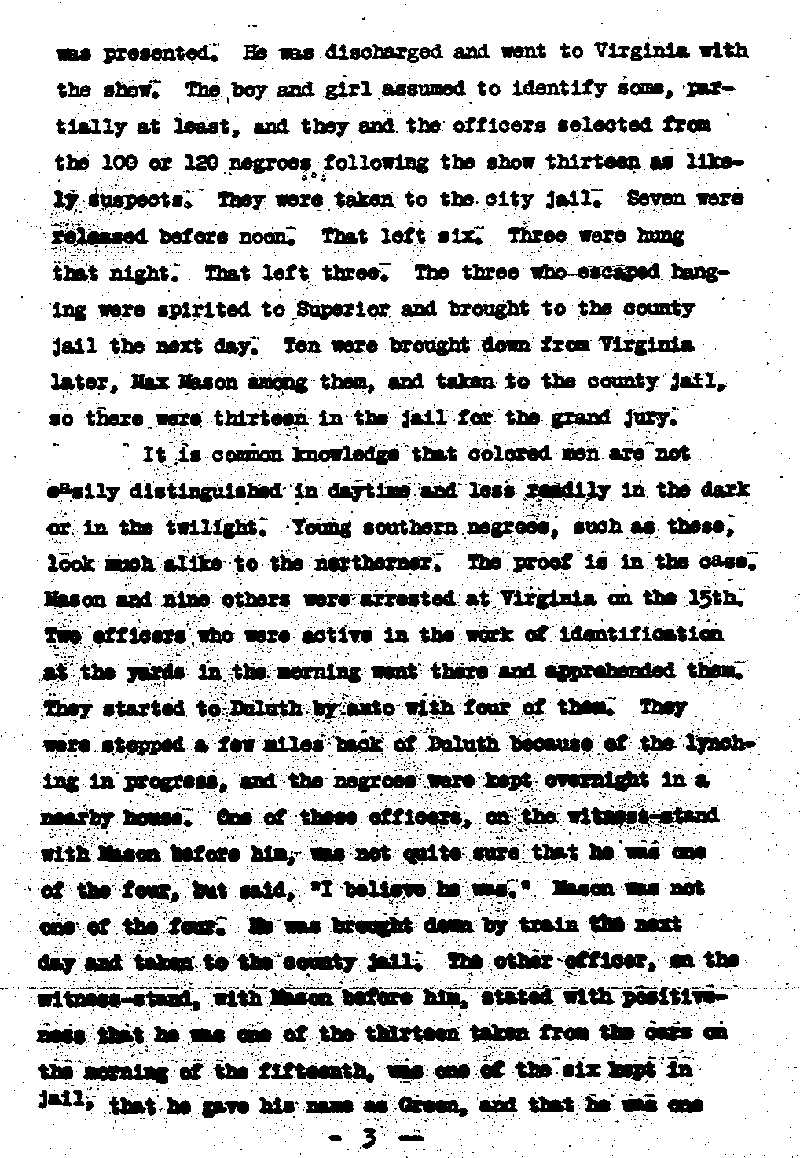
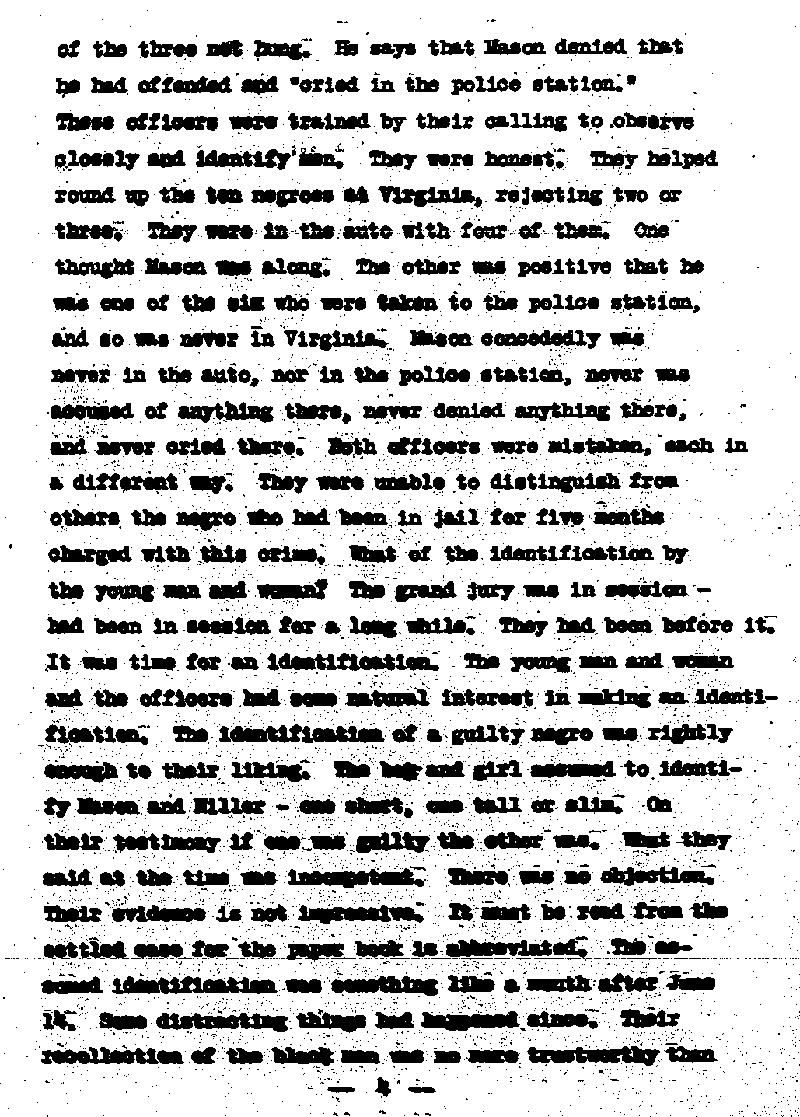
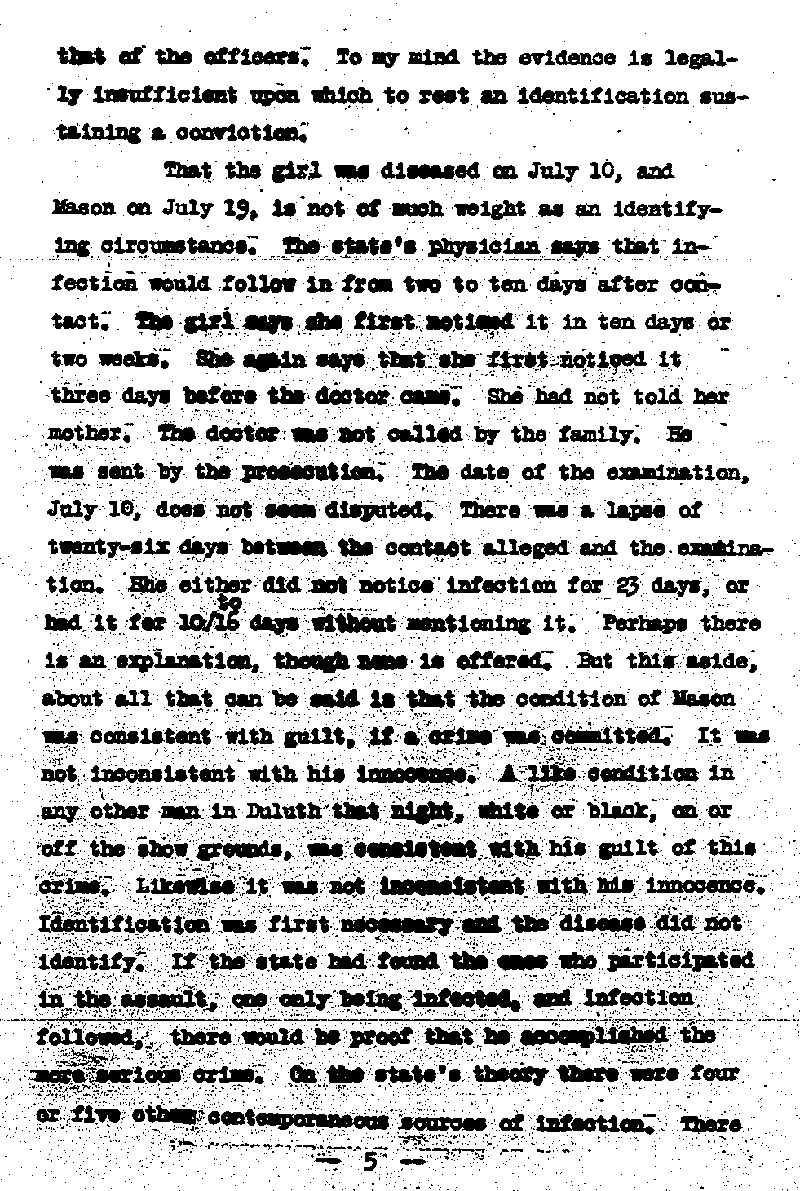
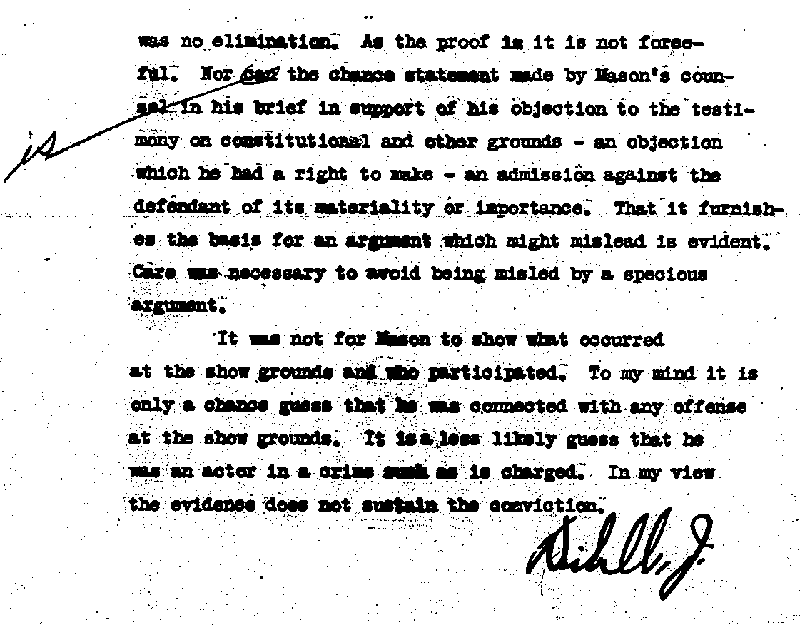
Image text
No. 22590.
STATE OF MINNESOTA
SUPREME COURT
State of
Minnesota,
Respondent
vs.
Max
Mason,
Appellant
OPINION AND SYLLABUS
Filed June 9th 1922
H. Mueller
Clerk
By Peter [illegible]
Hallam, J.
Dissent: Dibell, J.
No. 60 Hallam, J.
6/6/22. St. Louis County. Dissent, Dibell,
J.
State of Minnesota,
Respondent
22590 –-vs—
Max Mason,
Appellant.
SYLLABUS
1. The constitution of this state provides that no person shall be compelled
in any criminal case to be a witness against himself. Under this provision a man
cannot be compelled to give evidence against himself before a grand jury, but
one called before a grand jury investigating a particular crime may be indicted
on the evidence of others, so long as he is not compelled to give evidence
against himself. No constitutional right of the defendant in this case was
impaired.
2. The identification of defendant as one of those engaged in the
commission of a crime charged was sufficient. Identification may be sufficient
though the person making it cannot remember the face of the person identified.
Identification based upon other peculiarities may be reasonably sure.
3. In
a prosecution for rape evidence is admissible that the defendant had a venereal
disease and that the complainant soon after the alleged commission of the crime
contracted the same disease. The evidence in this case as to the time when
defendant and complainant had such a disease is sufficient to render it
admissible.
4. In a prosecution for rape, penetration may be proven by
circumstantial evidence. The evidence of penetration in this case was
sufficient.
Affirmed.
OPINION
Defendant was convicted of the crime of rape. He appeals from an order denying a motion for a new trial. It appears that on June 14, 1920, Robinson’s Circus cam to Duluth. The testimony on the part of the state is as follows: In the evening after dark, a young woman of 19 was about the circus grounds in company with a young high school boy. They mingled in the crowd outside the tents but after a while found themselves at a place from which all other spectators had gone. On turning to go themselves, they were suddenly confronted by five or six negroes attached to the circus, who blocked their path. One place a gun at the young man’s head and threatened to shoot if he spoke. Another seized the young woman and placed his hand over her mouth. Both were forced to go to a ravine about a block away. The young woman there became unconscious and all of the negroes save one ravished her. She became conscious as this last one was assaulting her. Both were then released and were directed to go in a direction opposite from the circus. The young man escorted the young woman to her home and then went to work at night employment at which he was engaged but soon sought out his father and told him the story. The families of both young people immediately took the matter up and reported the facts to the police. A number of negroes attached to the circus were arrested on suspicion and on the following morning were brought before the young people. Naturally both were very much excited. They could identify none of them. Later and about the middle of July, they mad the identification of defendant and one other. This identification will be referred to hereafter in more detail. Defendant and other were indicted. While investigation was going on and two day after the crime was committed, there came the lamentable occurrence of a frenzied crowd taking the law into their own hands. No
--2--
violence was done to this defendant.
1. Defendant moved to quash the
indictment on the ground that he had been called before the grand jury that
returned the indictment against him and was there compelled to testify against
himself. The trial court denied the motion.
The Constitution of the State
very explicitly provides the “no person - - shall be compelled in any
criminal case to be a witness against himself.” Art. 1, Sec. 7. The
language is unequivocal. Nothing can be detracted from it; nothing added to it.
It forbids that a man be compelled to give evidence against himself before a
grand jury as well as in court. State v. Froiseth, 16 Minn. 296; State v.
Gardner, 88 Minn. 130. He cannot be compelled to give evidence as to any facts
tending to accuse himself of crime or to prove any link in the chain of
testimony which is necessary to convict him of a crime. 3 Wigmore on Evidence,
Sec. 2260; State v. Garner, Supra. The constitutional provision does not,
however, prohibit receiving a man’s evidence even against himself if he is
not compelled to give it, and it does not prohibit his being compelled to give
testimony against another, even though he may be charged with or suspected of
the same crime; not does it prohibit the state from calling before a grand jury
one suspected of a crime under investigation, so long as he is not compelled to
give evidence against himself. Hawley v. Wallace, 137 Minn. 183, and there is
nothing in the constitution which prohibits the grand jury before which he is so
called and examined from indicting him on the evidence of others. The
constitution makers had no purpose to tie the hands of the state so that it may
not investigate intelligently the authorship of crime. Bearing those principles
in mind the disposition of this question is
--3--
simple. The motion to quash was heard on conflicting affidavits. Those presented by the state aver, that defendant was called in the course of a general investigation of the facts concerning the crime against the young woman with no particular charge against anyone, that he was not compelled to give evidence against himself by was distinctly told that he was not asked to do so. From the affidavits presented, the trial judge might find these to be the facts. On this state of facts we have no hesitation in saying the defendant’s constitutional rights were not impaired.
2. It is said the identification of defendant was not sufficient. The jury
might have so found. But they found it sufficient and the evidence justifies
this finding. When defendant was first brought before them, neither the young
man or the young woman identified him. Later both of them did so. A number of
negroes were taken to the scene of the crime on evenings when the light was
about the same as it was when the crime was committed. There they were brought
before the young man and the young woman separately and each acting
independently, picked out defendant as one of the guilty men. Both said they
identified defendant, not from his face, but from his size, his general
appearance, his talk and his walk. If but one had identified defendant in this
manner the evidence might properly be considered weak, but when both, acting
independently, picked out defendant, the testimony became much stronger.
Identification may be sufficient though the person making it cannot remember the
face. Identification based upon other peculiarities may be reasonably
sure.
These further facts are important. Dr. Nicholson gave evidence that he
examined defendant about the middle of July, and defendant then had a venereal
disease which he had probably had as much as a month before and that
defendant
--4--
admitted to him that he had the disease and that he had received no attention since he had been up there. He examined the other negroes who were accused and none were diseased. Dr. Coventry testified that on July 10, the young woman was suffering from the same disease and that the disease manifests itself from two to ten days after contact. She testified that she first noticed evidence of the disease ten days or two weeks after June 14. On cross-examination she impaired the force of this statement as to time. She testified however, that she had never had intercourse with any other man. It seems clear without comment that this testimony taken all together made out a chain of circumstantial evidence corroborative of the testimony of the young man and woman. Sec. 33 Cys. 1476; People v. Glover, 71 Mich. 503.
3. Defendant contends that it was error to receive this line of testimony.
He admits that it “probably was of controlling influence with the
jury.” This admission in itself goes far toward determining its
admissibility for the courts should be slow to exclude in a low suit, classes of
evidence which are precisely the considerations that would influence men of
affairs in deciding a business proposition. Connected as the facts are, we are
of the opinion that the testimony was all clearly admissible.
4. Defendant
contends that no crime was proven because no one testified to the fact of
penetration. The complaining witness was unconscious at the time of the assault
and it is said the young man, who was a few feet away did not give explicit
proof on this point. The contention is not sustained. There is abundant evidence
of assault with the purpose of committing rape. Penetration, like any other
fact, may be proved by circumstantial evidence. People v. Scouten, 130 Minn.
620; Taylor
--5--
v. State, 111 Ind. 279. It is often necessary to so prove it. Usually the
only persons present are defendant and complainant. It would be unthinkable to
hold that because the criminal renders his victim unconscious no proof can be
mad of the crime. The proof in this case is sufficient. There is the evidence of
the young man which for all practical purposes is direct proof. There is the
proof of ensuing disease, and there is proof of numerous slightly corroborative
circumstances. The evidence of a physician who examined complainant that he
could not say there had been penetration is not conclusive that penetration had
not taken place. The Doctor himself made that clear.
We find no error in the
record and the order appealed from is affirmed.
Hallam J.
The story upon which the conviction rests is a strange one. The young man and
woman separated themselves from two other boys and girls. They wandered about.
They, like others, watched the animals as they were taken from the menagerie.
Suddenly they were alone. They were attacked by six negroes, taken unobserved by
anyone to a secluded spot a block away, and this girl was assaulted by the six
successively, and ravished, as the opinion says, by five, the last two of the
six quarreling over the right of precedence. One Negro held a gun pointed at the
young man. He was quiet throughout.
Continuing the story it is proper to
note that the young man and woman, when released and told not to return to the
show grounds, walked a few blocks to the Merritt school-house, sat there on the
steps talking for a few minutes, walked beck to the Grand avenue car line, took
a car and rode west ten blocks, and then walked two or three blocks to the young
woman’s home. They sat on the porch for a while talking. The father was in
the house reading. The mother had retired. The young man then left, took the
street car home, going past the show grounds, and thence to the docks and to
work. The young woman went upstairs, passing her father with the remark,
“I am going to bed,” stopped at her mother’s room, saying,
“Mama, I met Jimmie tonight and we went to the circus,” received the
kindly response, “All right, dear, go to bed now,” went to her room,
then to the bathroom, and then to bed an to sleep. She made no complaint.
“While the rule requiring immediate complaint is not inflexible, yet the
unexplained failure to do so is a very important fact. It is so natural as to be
almost inevitable that a female
--1--
upon whom the crime had been committed will make immediate complaint, if she
have a mother or other confidential friend to whom she can make it. The rule is
founded upon the laws of human nature.” State v. Connelly, 57 Minn.
452.
Some time between one and two she was awakened by her mother, and later
went to the Canadian Northern yards to identify the negroes. The family
physician called at ten. He knew the occasion of his call. He had the sympathy
attendant upon the relation of family physician and patient. He “found a
normal condition,” though “she seemed slightly nervous; the physical
condition was good.” His examination was through. There were no abrasions
nor bruises nor inflammation nor evidence of soreness or tenderness. He did not
call again. Some of the best evidence of a crime, if there was one of this kind,
was not preserved. State v. Cowing, 99 Minn. 123, 134. There is other testimony
that the girl was “very hysterical and nervous” for several days. So
were other Duluth people in the days following June 14. Mason denied that he was
guilty, claimed that her was at work, and was corroborated by some of his Negro
fellow workers. There is perhaps a possibility that six negroes committed the
crime just as charged. Convictions are not rested on possibilities. This story
in its entirety is unusual and strikingly improbable.
Now pass to the
identification. Mason was brought before the young man and woman at the yards
about 5 in the morning of June 15. They did not identify him. There is testimony
that the girl shook her head when Mason
--2--
was presented. He was discharged and went to Virginia with the show. The boy
and girl assumed to identify some, partially at least, and they and the officers
selected from the 100 or 120 negroes following the show thirteen as likely
suspects. They were taken to the city jail. Seven were released before noon.
That left six. Three were hung that night. That left three. The three who
escaped hanging were spirited to Superior and brought to the county jail the
next day. Ten were brought down from Virginia later, Max Mason among them, and
taken to the county jail, so there were thirteen in the jail for the grand
jury.
It is common knowledge that colored men are not easily distinguished
in daytime and less readily in the dark or in the twilight. Young southern
negroes, such as these, look much alike to the northerner. The proof is in the
case. Mason and nine others were arrested at Virginia on the 15th. Two officers
who were active in the work of identification at the yards in the morning went
there and apprehended them. They started to Duluth by auto with four of them.
They were stopped a few miles back of Duluth because of the lynching in
progress, and the negroes were kept overnight in a nearby house. One of these
officers, on the witness stand with Mason before him, was not quite sure that he
was one of the four, but said, “I believe he was.” Mason was not one
of the four. He was brought down by train the next day and taken to the county
jail. The other officer, on the witness stand, with Mason before him, stated
with positiveness that he was one of the thirteen taken from the cars on the
morning of the fifteenth, was one of the six kept in jail, that he gave his name
as Green, and that he was one
--3--
of the three not hung. He says that Mason denied that he had offended and “cried in the police station.” These officers were trained by their calling to observe closely and identify men. They were honest. They helped round up the ten negroes at Virginia, rejecting two or three. They were in the auto with four of them. One thought Mason was along. The other was positive that he was one of the six who were taken to the police station, and so was never in Virginia. Mason concededly was never in the auto, nor in the police station, never was accused of anything there, never denied anything there, and never cried there. Both officers were mistaken, each in a different way. They were unable to distinguish from others the Negro who had been in jail for five months charged with this crime, what of the identification by the young man and woman? The grand jury was in session—had been in session for a long while. They had been before it. It was time for an identification. The young man and woman and the officers had some natural interest in making an identification. The identification of a guilty Negro was rightly enough to their liking. The boy and girl assumed to identify Mason and Miller—one short, one tall or slim. On their testimony if one was guilty the other was. What they said at the time was incompetent. There was no objection. Their evidence is not impressive. It must be read from the settled case for the paper book is abbreviated. The assumed identification was something like a month after June 14. Some distracting things had happened since. Their recollection of the black men was no more trustworthy then
--4--
that of the officers. To my mind the evidence is legally insufficient upon
which to rest an identification sustaining a conviction.
That the girl was
diseased on July 10, and Mason on July 19, is not of much weight as an
identifying circumstance. The state’s physician says that infection would
follow in from two to ten days after contact. The girl says she first noticed it
in ten days or two weeks. She again says that she first noticed it three days
before the doctor came. She had not told her mother. The doctor was not called
by the family. He was sent by the prosecution. The date of the examination, July
10, does not seem disputed. There was a lapse of twenty-six days between the
contact alleged and the examination. She either did not notice infection for 23
days, or had it for 10 to 16 days without mentioning it. Perhaps there is an
explanation, though none is offered. But this aside, about all that can be said
is that the condition of Mason was consistent with guilt, if a crime was
committed. It was not inconsistent with his innocence. A like condition in any
other man in Duluth that night, white or black, on or off the show grounds, was
consistent with his guilt of this crime. Likewise it was not inconsistent with
his innocence. Identification was first necessary and the disease did not
identify. If the state had found the ones who participated in the assault, one
only being infected, and infection followed, there would be proof that he
accomplished the more serious crime. On the state’s theory there were for
or five other contemporaneous sources of infection. There
--5--
was no elimination. As the proof is it is not forceful. Nor is the chance
statement made by Mason’s counsel in his brief in support of his objection
to the testimony on constitutional and other grounds—an objection which he
had a right to make—an admission against the defendant of its materiality
or importance. That it furnishes the basis for an argument which might mislead
is evident. Care was necessary to avoid being misled by a specious
argument.
It was not for Mason to show what occurred at the show grounds and
who participated. To my mind it is only a chance guess that he was connected
with any offense at the show grounds. It is a less likely guess that he was an
actor in a crime such as is charged. In my view the evidence does not sustain
the conviction.
Dibell, J.

